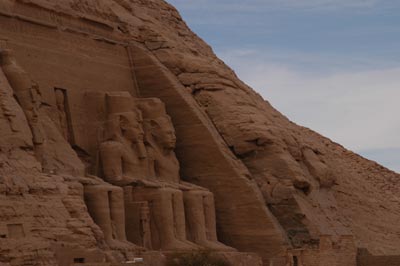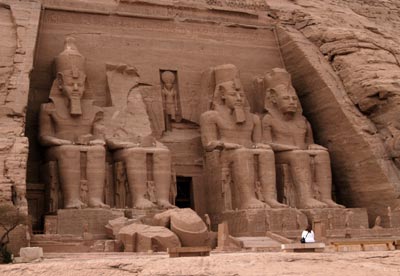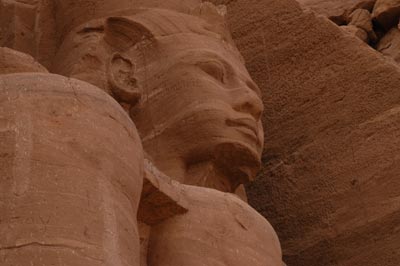










more photos
[ 1 ] [ 2 ] [ 3 ] [ 4 ] [ 5 ] [ 6 ]
Site details
open 0600 - dusk
entrance fee: £E36
no charge for camera
£E400 for video camera
relevant links
history
Temple of Ramesses II
The enormous statues that front the Sun Temple of Ramesses II in Abu SImbel are simply awesome, and seeing them was definitely one of the highlights of our trip. Four colossi sit in front of the temple, which is hewn into the rock face.

first glance of the facade of the King's Temple
Well, not exactly hewn into the rock face, since the "rock face" is now a completely false mountain that is built over a concrete dome and covered with landfill and artfully carved tocks. The temple was moved by UNESCO in the late 1960s to avoid being flooded by Lake Nasser, although if you didn't know that it had been cut into 1060 blocks and moved to this false mountain, you never would guess. The illusion is nearly complete, if you can ignore the few access panels that are visible in the rock face.
Ramesses II (usually called "The Great") was a 19th Dynasty pharaoh with an ego just about as large as Egypt herself. OUr guides referred to him as "The Coca Cola Pharaoh", since he seemed intent on ensuring that he was remembered by creating more statues and more inscriptions than any other pharaoh. His name is literally everywhere, often carved in over the top of other pharaoh's names deeper and larger, as if to cement his position in history. One almost thinks that "he doth protest too much" and all this monumental building was to make up for a lack of actual accomplishment.

the four monumental colossi -- the tiny white
blob in the front is me!
The four statues, 21 meters high, stare south at the border; watching for the next invasion with a forbidding gaze. Each of the statues wears the double crown, although the second statue has lost it's head and shoulders (in an earthquake in 27 BCE it is thought). Ramesses seems almost to smile, almost. The four colossi are not identical; they appear to show Ramesses in different stages of his life.
I had first seen the Temple in a book of drawings by David Roberts, with the statues nearly buried in fine sand. It was a stirring sight -- and somehow the completely excavated temple is just a bit less mysterious, if no less stunning. The temple was rediscovered in 1813 by a Swiss explorer Jean-Louis Burchhardt. It was purposefully reburied in the 19th century to protect it.

The northern head, still flecked with plaster
and coffee
The famous "explorer" Belzoni managed to get inside, but there was no treasure to be found, so he abandoned the site. In 18xx, Robert Hay took a cast of the face of the northern statue (the one on the right) with plaster, staining the porous sandstone. THe spots were later dyed with coffee to hide them. You can still see flecks of pale stone on the statue. Once cleared, in the early part of the century, the temple because a feature of early cruise operators, notably Thomas Cook. [ more ]